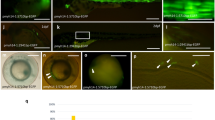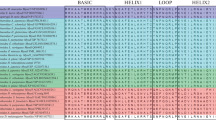Abstract
Myosin heavy chain (MYH) genes belong to a multigene family, and the regulated expression of each member determines the physiological and contractile muscle properties. Among these, MYH6, MYH7, and MYH14 occupy unique positions in the mammalian MYH gene family because of their specific expression in slow/cardiac muscles and the existence of intronic micro(mi) RNAs. MYH6, MYH7, and MYH14 encode miR-208a, miR-208b, and miR-499, respectively. These MYH encoded miRNAs are designated as myomiRs because of their muscle-specific expression and functions. In mammals, myomiRs and host MYHs form a transcription network involved in muscle fiber-type specification; thus, genomic positions and expression patterns of them are well conserved. However, our previous studies revealed divergent distribution and expression of MYH14/miR-499 among teleosts, suggesting the unique evolution of myomiRs and host MYHs in teleosts. Here, we examined distribution and expression of myomiRs and host MYHs in various teleost species. The major cardiac MYH isoforms in teleosts are an intronless gene, atrial myosin heavy chain (amhc), and ventricular myosin heavy chain (vmhc) gene that encodes an intronic miRNA, miR-736. Phylogenetic analysis revealed that vmhc/miR-736 is a teleost-specific myomiR that differed from tetrapoda MYH6/MYH7/miR-208s. Teleost genomes also contain species-specific orthologs in addition to vmhc and amhc, indicating complex gene duplication and gene loss events during teleost evolution. In medaka and torafugu, miR-499 was highly expressed in slow/cardiac muscles whereas the expression of miR-736 was quite low and not muscle specific. These results suggest functional diversification of myomiRs in teleost with the diversification of host MYHs.






Similar content being viewed by others
References
Akolkar DB, Kinoshita S, Yasmin L, Ono Y, Ikeda D, Yamaguchi H (2010) Fiber type-specific expression patterns of myosin heavy chain genes in adult torafugu Takifugu rubripes muscles. J Exp Biol 213:137–145
Andreassen R, Worren MM, Hoyheim B (2013) Discovery and characterization of miRNA genes in Atlantic salmon (Salmo salar) by use of a deep sequencing approach. BMC Genomics 14:482
Bell ML, Buvoli M, Leinwand LA (2010) Uncoupling of expression of an intronic microRNA and its myosin host gene by exon skipping. Mol Cell Biol 30:1937–1945
Berdougo E, Coleman H, Lee DH, Stainier DY, Yelon D (2003) Mutation of weak atrium/atrial myosin heavy chain disrupts atrial function and influences ventricular morphogenesis in zebrafish. Development 130:6121–6129
Bhuiyan SS, Kinoshita S, Wongwarangkana C, Asaduzzaman M, Asakawa S, Watabe S (2013) Evolution of the myosin heavy chain gene MYH14 and its intronic microRNA miR-499: muscle-specific miR-499 expression persists in the absence of the ancestral host gene. BMC Evol Biol 13:122
Desjardins PR, Burkman JM, Shrager JB, Allmond LA, Stedman HH (2002) Evolutionary implications of three novel members of the human sarcomeric myosin heavy chain gene family. Mol Biol Evol 19:375–393
Hoegg S, Brinkmann H, Taylor JS, Meyer A (2004) Phylogenetic timing of the fish-specific genome duplication correlates with the diversification of the teleost fish. J Mol Evol 59:190–203
Ikeda D, Ono Y, Snell P, Edwards YJ, Elgar G, Watabe S (2007) Divergent evolution of the myosin heavy chain gene family in fish and tetrapods: evidence from comparative genomic analysis. Physiol Genomics 32:1–15
Kim JM, Lim KS, Hong JS, Kang JH, Lee YS, Hong KC (2014) A polymorphism in the porcine miR-208b is associated with microRNA biogenesis and expressions of SOX-6 and MYH7 with effects on muscle fibre characteristics and meat quality. Anim Genet 46:73–77
Kinoshita S, Bhuiyan SS, Ceyhun SB, Asaduzzaman M, Asakawa S, Watabe S (2011) Species-specific expression variation of fish MYH14, an ancient vertebrate myosin heavy chain gene ortholog. Fish Sci 77:847–853
Kloosterman WP, Steiner FA, Berezikov E, de Bruijn E, van de Belt J, Verheul M, Cuppen E, Plasterk RH (2006a) Cloning and expression of new microRNAs from zebrafish. Nucleic Acid Res 34:2558–2569
Kloosterman WP, Wienholds E, de Bruijn E, Kauppinen S, Plasterk RH (2006b) In situ detection of miRNAs in animal embryos using LNA-modified oligonucleotide probes. Nat Methods 3:27–29
McGuigan K, Phillips PC, Postlethwait JH (2004) Evolution of sarcomeric myosin heavy chain genes: evidence from fish. Mol Biol Evol 21:1042–1056
Morkin E (2000) Control of cardiac myosin heavy chain gene expression. Microsc Res Tech 50:522–531
Nei M, Gojobori T (1986) Simple methods for estimating the numbers of synonymous and nonsynonymous nucleotide substitutions. Mol Biol Evol 3:418–426
Schiaffino S, Reggiani C (2011) Fiber types in mammalian skeletal muscles. Physiol Rev 91:1447–1531
Tajima F, Nei M (1984) Estimation of evolutionary distance between nucleotide sequences. Mol Biol Evol 1:269–285
Tamura K, Nei M (1993) Estimation of the number of nucleotide substitutions in the control region of mitochondrial DNA in humans and chimpanzees. Mol Biol Evol 10:512–526
Tamura K, Peterson D, Peterson N, Stecher G, Nei M, Kumar S (2011) MEGA5: molecular evolutionary genetics analysis using maximum likelihood, evolutionary distance, and maximum parsimony methods. Mol Biol Evol 28(10):2731–2739
van Rooij E, Sutherland LB, Qi X, Richardson JA, Hill J, Olson EN (2007) Control of stress-dependent cardiac growth and gene expression by a microRNA. Science 316: 575–579
van Rooij E, Quiat D, Johnson BA, Sutherland LB, Qi X, Richardson JA, Kelm RJ Jr, Olson EN (2009) A family of microRNAs encoded by myosin genes governs myosin expression and muscle performance. Dev Cell 17:662–673
Wang X, Ono Y, Tan CS, Chai RJ, Philip C, Ingham PW (2011) Prdm1a and miR-499 act sequentially to restrict Sox6 activity to the fast-twitch muscle lineage in the zebrafish embryo. Development 138:4399–4404
Weiss A, McDonough D, Wertman B, Acakpo-Satchivi L, Montgomery K, Kucherlapati R, Leinwand L, Krauter K (1999a) Organization of human and mouse skeletal myosin heavy chain gene clusters is highly conserved. Proc Natl Acad Sci U S A 96:2958–2963
Weiss A, Schiaffino S, Leinwand LA (1999b) Comparative sequence analysis of the complete human sarcomeric myosin heavy chain family: implications for functional diversity. J Mol Biol 290:61–75
Yelon D, Horne SA, Stainier DY (1999) Restricted expression of cardiac myosin genes reveals regulated aspects of heart tube assembly in zebrafish. Dev Biol 214:23–37
Acknowledgments
This study was partly supported by a grant-in aid for scientific research from the Japan Society for the Promotion of Science.
Author information
Authors and Affiliations
Corresponding author
Ethics declarations
Conflict of Interest
The authors declare that they have no competing interests.
Electronic Supplementary Material
Below is the link to the electronic supplementary material.
Supplementary Figure 1
Molecular phylogenetic analysis of host MYHs and related paralogs by neighbor-joining (NJ) method. The percentage of replicate trees in which the associated taxa clustered together in the bootstrap test (1000 replicates) are shown next to the branches. Boxed MYHs are myomiR containing ones. Abbreviations used: Hs, human (Homo sapiens); Mm, mouse (Mus musculus); Xt, frog (Xenopus tropicalis); Lo, spotted gar (Lepisosteus oculatu); Tr, torafugu (Takifugu rubripes); Ol, medaka (Olyzias latipes); Dr, zebrafish (Danio rerio); Ci, Ciona intestinalis. (PPTX 45 kb)
Rights and permissions
About this article
Cite this article
Siddique, B.S., Kinoshita, S., Wongkarangkana, C. et al. Evolution and Distribution of Teleost myomiRNAs: Functionally Diversified myomiRs in Teleosts. Mar Biotechnol 18, 436–447 (2016). https://doi.org/10.1007/s10126-016-9705-9
Received:
Accepted:
Published:
Issue Date:
DOI: https://doi.org/10.1007/s10126-016-9705-9




